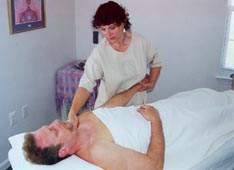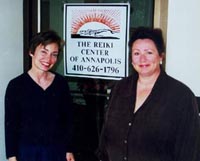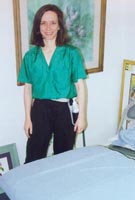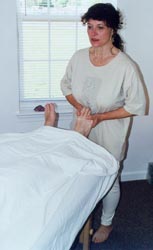 My
Journey
My
JourneyThrough the Holistic Universe
 My
Journey
My
Journey
Through the Holistic Universe
by Darcey Dodd
The ad said I should treat myself to a day of holistic healing. Relax my mind and body. Indulge a little. That's how I ended up sampling holistic wares on a couple of Sunday afternoons ...
photo by Darcey Dodd "You can see broken hearts and you can see heart attacks," said palmist Kathy Withrow, left.
In a galaxy far, far away
Hands rest on my face, covering my eyes. I hear her
breathing heavy. So heavy, I wonder if she's meditating.
A faint ring of organ music makes the intense breathing more eerie.
Nearby a voice echoes a sentence over and over. I can't quite make it out, but it sounds like chanting.
When she shifts her hands to my neck, I'm able to peek around the room. It's dark, but I can see outlines of many bodies. Some lie motionless on tables. Others surround those, swiftly inhaling and expelling air.
For a moment, I think I'm stuck in a scary scene from Invasion of the Body Snatchers. I tell myself to snap out of it and concentrate. Breathe in and out. Focus on your body.
Though I'm skeptical, I secretly wish this will heal my
soul.
How I ended up sampling holistic wares in a couple of Sunday afternoons of healing is no mystery. The ad said I should treat myself to a day of holistic healing. Relax my mind and body. Indulge a little.
Holistic? I wasn't sure what I was getting myself into, but being spoiled couldn't be bad. And besides, I could use a massage and maybe try out that yoga exercise everyone's raving about.
Now I'm wondering what is happening to me on this table.
photos by Mark Burns Massage therapistsAurora Youngs.
Getting into the (Energy) Flow
I get some answers from reiki master Katherine Klemstine. "Reiki is an ancient healing art that dates back 2,500 years," Klemstine begins. "It's the balance of life force."
Klemstine and her partner, Ethel Porter, have taught and practiced the traditional Usui Reiki system at their Reiki Center in Annapolis for five years.
Here's the idea. The practitioner facilitates the flow of energy through
her hands.  "The person receiving
is drawing energy from the universe," adds practitioner Sharon Rieger,
who introduced me to reiki at my first afternoon of holistic healing. That
was at Unity by the Bay, a spiritual center in Severna Park, one of several
spots throughout Chesapeake Country I'd visit on my journey.
"The person receiving
is drawing energy from the universe," adds practitioner Sharon Rieger,
who introduced me to reiki at my first afternoon of holistic healing. That
was at Unity by the Bay, a spiritual center in Severna Park, one of several
spots throughout Chesapeake Country I'd visit on my journey.
Reiki is useful when "the flow of life force becomes disruptive due to lifestyle or trauma - physical or mental," continues Klemstine, who discovered reiki during a stressful time in her own life. "It brings the flow of ki (a Japanese word meaning vital force) back to its natural balance."
Does it really work? There's no certain, scientific evidence that Reiki cures or prevents disease, but there's plenty of anecdotal evidence that it can help reduce symptoms of stress and create a sense of well-being.
It uses gentle touch, like massage. "Reiki will never hurt you," says Rieger. "In the least, you will come away feeling relaxed."
And that I did. The force is with me.
photo by Mark Burns Katherine Klemstine and Ethel Porter teach and practice reiki at their Reiki Center in Annapolis.
Hands On
Speaking of massage, I never knew there was such a variety to choose from. 'How delightful,' I think as I listen to the differences.
Among the most popular is the Swedish massage - a basic rub down. This contemporary Western massage is good for general relaxation, but relaxation isn't what you get from this deep-tissue massage. "Deep tissue is very vigorous and can be intense," says certified massage therapist and mother of four Mary Hokanson. Though best for specific aches, this sort can hurt before it helps.
Massage covers any kind of systematic manipulation of the soft tissues of the body.
Myofascial massage, another deep form, is used to soften connective fascia - tissue that surrounds bones and internal organs throughout the body. According to Hokanson, this massage allows different layers to move, which can improve circulation and chemical transfer.
There's also a lymph drainage massage that's used to gently get the lymph - a fluid circulating through the body that carries impurities away and brings white blood cells to fight infections - flowing. "I've seen it help people with diverse problems including neck and digestive problems," says Aurora Youngs of the Chesapeake Healing Arts Center in Prince Frederick.
According to the American Massage Therapy Association, good circulation is key because the body's cells are reliant on nutrients and oxygen supplied by the blood and lymph. Studies consistently prove the healing powers of massage.
But massage doesn't work on the body alone.
"Holistic deals with the whole person - body, mind and spirit," says Hokanson, who works on clients at the Natural Healing centers in Annapolis and Severna Park. "Massage treats not only physical but emotional stress."
Many practitioners think of massage as therapeutic touch. Hokanson and others believe touch is something Americans need more of. "Growing up in Hawaii, I found the Polynesians very affectionate. Touch is a part of life," says Hokanson. "My purpose is to get people touching."
Timidly, I choose a Swedish massage. While the therapist's hands run up my legs and back, I take in the sounds of the taped ocean surf. Candle flames dance on the walls, and it's all I can do to stay awake. What is that soothing scent?
Used by ancient Romans and commonly in perfumes, lavender aromatic oil can relieve tension and depression and treat burns. It's just one of many odors used in aromatherapy, the inhalation or skin contact of fragrant oils extracted from plants to heal. It's the power of scent.
How powerful remains uncertain. So far, science has proven that smell can change moods and evoke memories. That's not so hard to believe when you think of aromas like grandma's homemade apple pie stirring your stomach or grandpa's cigar sending you back to a childhood memory.
Essential oils can also ease stress, nausea, gas and other digestive problems; reduce arthritis pain; relieve sore throats; clear sinuses; and improve skin rashes and acne. They're often used along with massage.
Massage therapist Mary Hokanson.
A Life in My Hand
An hour later, I'm relaxed and a little sticky from the oil when I notice a sign reading 'Palmistry.' I'm giggling as I walk into that room.
The palmist takes both of my hands and tells me all sorts of things. I expected her to look exotic, maybe like a gypsy. And where is her crystal ball?
She seems too normal.
"I do it from a scientific view," says reader Kathy Withrow of Huntingtown. "Palms change as things change, affecting the nervous system."
Withrow, also the owner of Backwoods Bed & Breakfast in Huntingtown, began studying palmistry after several dud readings. "It's about events, family problems, careers, health. You can see broken hearts and you can see heart attacks," she tells me.
The human hand reveals evidence of a person's health, habits and cleanliness. Our palms have several lines and convolutions. Traditional Chinese palmistry says that each line has meaning. Typically a palm holds fate, heart, brain (or head), marriage (or love) and life lines.
"Most people think we're going to tell them when they're going to die. Nobody can do that," says Withrow.
I'm relieved to learn that. Even the most skeptical person would be bothered by that prediction.
Many palmists venture to diagnose disease, read events of the past and present and foretell the future by reading the hand's lines. They can even interpret character.
Withrow was surprised by what she saw on Newt Gingrich's hand the evening she found herself seated near him in a Virginia restaurant. "My perception of him from television was that he was a bully. His hand was soft-looking, and from what I could see he is a kind person," she says.
No two readings will be the same because many palmists' systems differ. Some believe the left hand symbolizes how a person was born or even things lurking in the back of one's mind. The right hand is where you are today. Withrow says one's palms are only significantly different when "a lot of things are going on in your life. Most of the time they are similar."
Mine were different. Two months after my palms were read, I'm different, too.
Truth in the Tootsies
It's a traditional Chinese belief that a part of the body contains the whole, as I learned with palmistry. But would you be shocked to discover that your feet tell a lot about your insides? I was, too.
Reflexology uses that principle by applying pressure to the hands or feet, where it is believed all of the body's internal structures and organs are mapped. So reflexology, as explained by my editor Sandra Martin, is "when they wiggle your toes and poke at your feet."
The favored theory is that the body is divided into 10 energy zones, called meridian lines, that run vertically, covering the entire body. The foot reflects the body, reflecting these zones in its components.
The tips of the big toes represent the head and brain. The heels of the feet mirror the lower back, hips, knees, ankles and feet. There are spots for everything in between, too, from the thyroid to the pancreas, gall bladder, spleen and spinal region.
A reflexologist gently applies pressure to reflex points on the foot, stimulating the energy lines, nerve endings and vascular flow to different parts of the body.
Besides a few tender spots, my tootsies give no sign of grotesque disorders.
photo by Mark Burns According to reflexology, your 10 toes reflect the state of your entire being.
A Less Sniffly Human Pincushion
Alternative treatments like reflexology have been around a long time. Acupuncture is one of the oldest, dating back as many as 5,000 years.
In the past, the thought of someone pricking me with needles made me cringe. How in the world could that heal me?
In sort of the same way as reflexology does. Tiny needles are inserted into specific points along the meridians to regulate the energy.
Acupuncture's system is based on nature's elements - fire, earth, metal, water and wood. The concept is that we are not separate from nature but part of it. I've never thought about it that way. But I'm learning that there's a lot I've never thought of.
"One of the beauties of Chinese medicine is that it's about keeping you well," explains master acupuncturist Brad Hill. "I use acupuncture to maintain wellness."
That does not mean acupuncture can't be used when a person is already ill. Coming in with the sniffles, I'm told that certain points may help since my cold is in its beginning stage.
There are 360 points, but Hill typically will not use more than four or five hair-thin needles at one time.
According to most acupuncturists, there are good reasons to get over your fear of needles. Acupuncture can, they say, lessen the frequency of sickness, strengthen your stamina and improve your respiratory, circulatory, immune, digestive and nervous system disorders.
Hill, who performs acupuncture full time at his home office and at Natural Healing, says his clients' reasons range. "I treat people who are in the late stages of cancer and people who are healthy but like the way it enhances their lives."
I can say this much: acupuncture didn't hurt and, though it could be in my head, I'm not sniffling nearly so much.
My Deep Workout
photo by Darcey Dodd "This is not a massage," says Rolfer David Swetz.
I'll tell you what does hurt, though. Rolfing. Well, it's one of those slightly painful during but damn-good-afterward experiences.
"This is not a massage," says one of a thousand worldwide certified Rolfers, David Swetz. "It's very deep specific work."
What Rolfing is, exactly, is a type of bodywork concentrated on the connective tissue surrounding muscles. Rolfing releases restrictions and allows the body to come back to its natural alignment with gravity. Realignment usually takes 10 one-hour sessions, each concentrating on a different area of the body.
"You can't zone out like you can with massage because you work with the Rolfer," advises Swetz, who Rolfs part-time at Chesapeake Healing Arts Center.
Anyone can benefit from this technique, but the athletic and those with poor posture, neck, back, ankle, foot or hand pain prosper most.
"A friend told me about it in 1992. I was into running and thought it might help with that," says Swetz, who continues to visit his Rolfer two or three times a year.
Rolfing, named after its founder, Dr. Ida P. Rolf, is gaining popularity. Swetz says so much so that familiar names like Charles Barkley and Willie Nelson have used it.
Into the Zen
Now that my body feels great, I think I will end the day learning how to meditate. Coming from a family of worriers, I've decided it's in my best interest to learn to ease out early in life.
Meditation comes in many forms. "Even five minutes can help reduce stress," says Jan Nicholson, psychologist and director of integrative medicine at Calvert Memorial Hospital. "It's great if you can set aside a regular time every day."
Whatever way works best for you is the best way. When your mind is relaxed, you've achieved successful meditation.
Zen, transcendental meditation, progressive relaxation, autogenic training, mindfulness, body scanning and yoga - all, believe it or not, are types of meditation.
Zen Buddhism is a religion based on meditation. Zen, meaning meditation in Chinese, is achieved when a person releases all stress by thinking of absolutely nothing.
Transcendental meditation, on the other hand, uses a word or phrase repeated over and over until the mind naturally drifts into a higher, more relaxing state.
Progressive meditation is the concentration of loosening every single body part, one at a time. This can dissolve headaches.
Autogenic training works on the premise that if you believe the body is feeling something, it will feel it. Mindfulness meditation is similar: rather than focusing on body parts, you imagine what is happening to them. Body scanning falls in this familiar range. Starting from the top of your body, your mind scans its way down.
I'm doing that last one. My head, my hair, the little chicken pox scar nobody can see, my eyes, nose, lips ahhh. I'm working my way down, slowly, focusing on one thing at a time. The rest can wait its turn.
Beginners beware. Do not try this while operating heavy machinery, like the Millennium Falcon. They tell me it's difficult to stay awake until you're used to it. I know that first-hand now.
There is one machine you might want to try while meditating, especially
if you fear you won't get it right or if you can't let yourself go. Nicholson
will attach diodes to your head while you meditate, concentrating on raising
your body heat. Your success is measured by a computer screen graphic in
which a sun rises from the horizon to the top of the sky as you warm your
body temperature. By knowing how to regulate your own temperature, you're
supposed to be able to relieve migraines and headaches.
"There's an awful lot of benefits," says Nicholson, who is also director of a center for holistic therapies at the hospital in a program called Healthy Alternatives. She says besides reducing stress, meditation can reduce stomach problems, alleviate PMS symptoms and help when a person is trying to overcome an addiction - to name a few.
I'm convinced, but I'm not yet into the Zen.
photo by Mark Burns Even five minutes of regular meditation are great for relieving stress, says Jan Nicholson, director of integrative medicine at Calvert Memorial Hospital.
My Journey Ends
Aches soothed, muscles loose and mind clear, I stroll away from this adventure with a new perspective. I have ways to let myself travel to another place, even if only for a few hours, to keep my mind, body and spirit intact.
I'm still slightly skeptical, but I know there's much more to investigate. With so many alternatives out there, one thing's for sure. I'm relaxed and prepared for anything that may come my way. That feels good.
Passing by, an elderly man in blue checkered pants and a fisherman's hat asks how my day was. I tell him it was amazing as I clench next weekend's list of appointments. I could get used to this.
This galaxy is not so far out.
Starting Your Tour
Now that you know what holistic therapies are all about, where do you go to get them?
That's easy. As the millennium approaches, holistic medicine is everywhere. You can find some form of alternative treatment right around almost every corner in salons, spas, healing centers and practitioners' homes. Even mainstream hospitals are incorporating holistic treatments with traditional medicine. Anne Arundel Medical Center introduced its Wellness Initiative a couple of years ago; now Calvert Memorial Hospital has added its own Healthy Alternatives program and is renovating a building to house it.
Among places I visited is Natural Healing, which began in Severna Park and recently opened a second office in Annapolis because of demand. Here you can find everything from acupuncture to internal spiritual healing to nutritional counseling. The same goes for Chesapeake Healing Arts Center in Calvert County.
Some, like the Reiki Center in Annapolis, specialize in one particular treatment. Others hold weekend or afternoon sessions, like mine, where you can choose from many samples for a small donation.
Many practitioners offer classes to teach you how to perform different therapies like massage, reiki, yoga and meditation. Healthy Alternatives, at Calvert Memorial Hospital in Prince Frederick, has a different workshop every third Wednesday of the month as part of their Wellness Series.
To find out more about alternative healing opportunities in Chesapeake Country, check out NBT's weekly Good Bay Times and monthly Wellness guide, especially this month's expanded coverage.
To learn more, call -
| Issue 23 |
Volume VII Number 23
June 10-16, 1999
New Bay Times
| Homepage |
| Back to Archives |